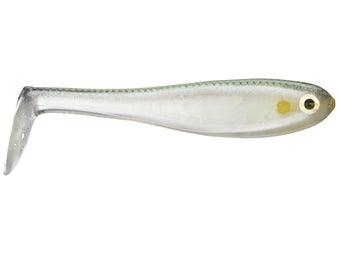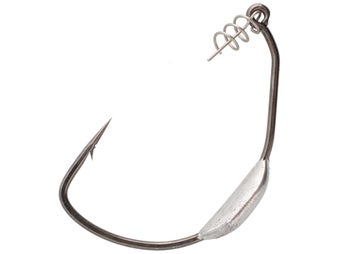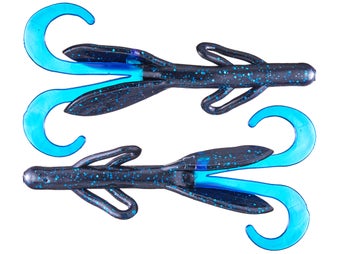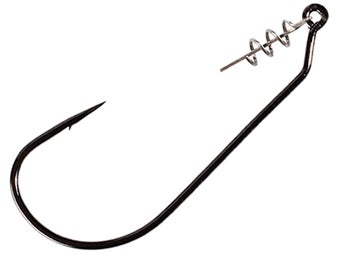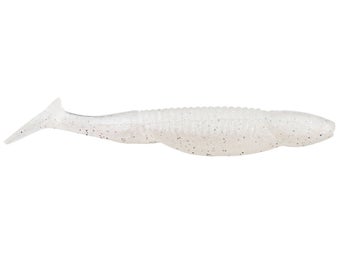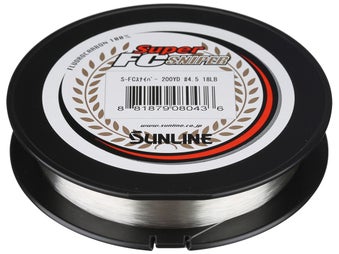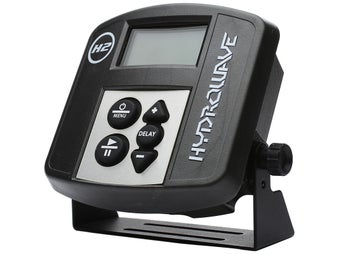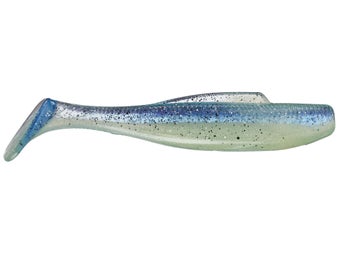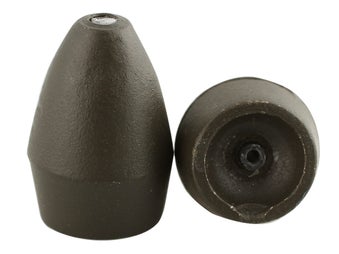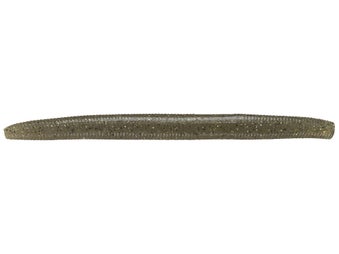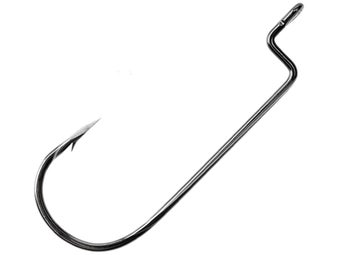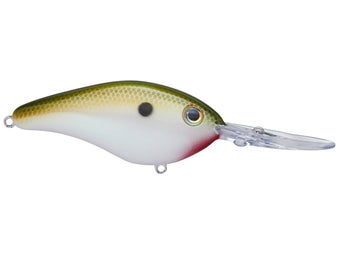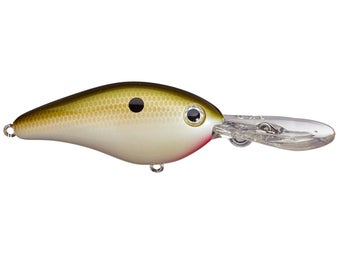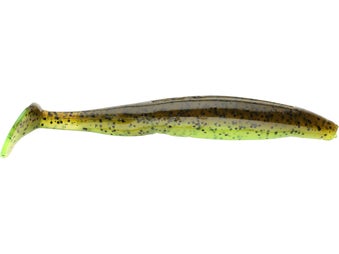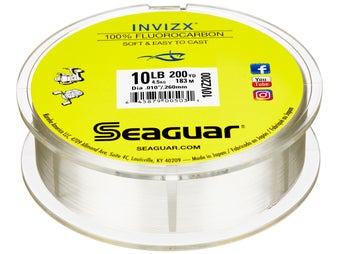Skeet Reese Wins BASS Lake Guntersville
Skeet Reese's Winning Pattern, Baits & Gear
Competition:
Reese's first fish of the event was a 4-pounder that he looked at and enticed with a Berkley Havoc Slop Craw. It ended up being the only one he took to the scale that didn't bite the Basstrix. He picked up four additional (smaller) bed-fish with a Berkley Havoc Bottom Hopper worm. With a limit in his box that weighed between 12 and 14 pounds, he pulled up to the point in Seibold Creek where he'd caught the 4-pounder on the last practice day. He caught a 2 3/4-pounder on the dropshot, then picked up the swimbait and popped one more than twice that size. He lifted that 6-pounder from the water in full view of Mike Iaconelli, and Iaconelli's non-reaction told Reese that the former already had a crowded livewell (that was the day Ike weighed a tournament-best 28-02). "It didn't even faze him," Reese said. "I knew right then that he'd already caught them real good." One of the fish he subsequently culled with was a 7-pounder and he lost a 6 and a 5. His stringer landed him in 4th place, just more than 3 pounds off Iaconelli's pace. One of the big ones that got away busted the knot that attached his swimbait to 65-pound braided line, and the same thing happened again early on day 2. That prompted him to insert a 25-pound fluorocarbon leader, and that resolved the break-off issue for the remainder of the event. Stormy day 2 saw him weigh what was by far his lightest bag of the derby and he dropped to 11th place. He figured the fish he lost that day, either to break-offs or pull-offs, cost him 4 or 5 pounds. Day 3 featured post-frontal conditions that caused much of the field to struggle, but Reese was a notable exception. The wind shifted from the south to a northeasterly direction and Seibold received much more turbulence than it normally does due to the creek's directional orientation. That benefited his swimbait program and he climbed all the way to 2nd, just 2 pounds off the lead.
He caught a couple of 3 1/2-pounders early on day 4 and filled a limit very quickly, then decided to pull out of Seibold. "I knew there were still some big ones around, but they hadn't repositioned themselves to be active yet," he said. "I'd seen another stretch (in Town Creek) the day before that had wood, and I caught a 3 1/2 and lost one that was 4 1/2 or 5. I knew that would give me some new water to fish the next day. "I went there and caught one that was 5 1/2 or 6 and another one that was 3 3/4. Then I tried to get on another spot where I'd caught four big ones during the tournament, but some locals were fishing it. I went back a couple hours later and they were gone, and I caught another 5 1/2." At about noon he'd pulled up BASSTrakk on his phone to try to determine where he stood. That was when he discovered that Iaconelli was having a miserable day (the 3-day leader would weigh just a single 3-pounder and drop all the way to 12th). "I was surprised to see I was leading, and that was good. The only thing I knew before that was I heard my cameraman say that Keith Combs (who started the day in 9th) had over 20 pounds. "Then I saw (David) Walker get within like 1-15, and that wasn't good. At Guntersville a guy can jack 7- or 8-pounders back to back, and that crushes a lead really fast." His late upgrades, however, left Walker and everyone else far behind.
Winning Pattern:
Reese said he made extremely long casts with the swimbait when he was working it over flats, points or humps, but his throws to laydowns were much shorter. About half of his weigh-in fish came from the wood. His retrieve rate varied, but was "pretty slow" the majority of the time. He threw a chartreuse shad Basstrix on day 1, but John Murray told him that evening that he thought the fish were biting ayu the best. Murray missed the day-2 cut he gave Reese two more of the baits. He tried to purchase additional baits for day 4, but couldn't locate any. He got one more pack on the morning of day 4 from Velvick, who'd somehow secured them locally. "I guess he had more clout than I did," Reese said.
Winning Pattern:
Swimbait gear: 7'4" heavy-action Wright & McGill Skeet Reese Victory Pro Carbon Jig/Big Worm rod, Wright & McGill Skeet Reese Victory Pro Carbon casting reel (6.4:1 gear ratio), 65-pound Spiderwire Stealth braided line, 25-pound Berkley Trilene 100% Fluorocarbon leader, 7/0 Laser TroKar weighted swimbait hook, 7" Basstrix Paddletail swimbait (chartreuse shad or ayu).
Main factor: "I think it was just fishing open-minded. Practice sucked, so I didn't want to repeat what wasn't working. I kept looking for new water and new places to fish throughout the tournament. Every day I'd find new spots and catch one or two big ones from areas I hadn't fished before."
Performance edge: "The rod, reel, line and hook were the key components."
Guntersville Elite Series Winning Pattern BassFan 4/15/15 (John Johnson)
Byron Velvick's Pattern, Baits & Gear
Swimbait gear: 7'11" heavy-action Duckett Fishing Byron Velvick Signature Series rod, Duckett Fishing casting reel (6.3:1 or 5.4:1 gear ratio), 25-pound Vicious fluorocarbon line, 8/0 or 10/0 Owner Beast heavy-cover hook, or 11/0 Basstrix Paddletail Swimbait Hook, 7" Basstrix Paddletail (ayu) or 8" prototype Livingston Lures (dark hitch) swimbait. He said that unlike many baits of that size, the new Livingston always runs upright. "The other ones, about 50 percent of them come out right and the other 50 percent are wrong because of the inconsistencies (in the manufacturing process). They do what I call 'halibuting' (turning over on their side) and there's no way to tune them."
Sight-fishing gear: 7'1" medium-heavy Duckett Fishing Byron Velvick Signature Series rod, same reel (7:1 ratio), 15-pound Vicious fluorocarbon, 1/2-ounce round dropshot weight (on 5" leader), 4/0 Owner TwistLock hook, 4" Tightlines UV-Hog (watermelon red). He used the whiskered version of the UV-Hog. "When it hit the water those whiskers would flare out and the fish were losing their minds over it."
Main factor: "Coming here knowing I was going to sight-fish and throw swimbaits, and that's it. I was literally not caring if Ish (Monroe) told me he was catching them on a frog or if (John) Murray said they were biting a Chatterbait. I wouldn't even go look or one."
Performance edge: "My Vicious sunglasses. I honestly believe I was seeing more fish deeper than most guys were."
Derek Remitz's Pattern, Baits & Gear
Bladed-jig gear: 7' medium-heavy St. Croix Legend Tournament Series rod, unnamed casting reel (7.2:1 ratio), 16- or 20-pound Sunline Reaction FC fluorocarbon line, 3/8- or 1/2-ounce Z-Man Chatterbait (baby bass), Reaction Innovations Little Dipper trailer (bad shad green).
Swimbait gear: 7'4" heavy-action St. Croix Avid X rod, unnamed casting reel (5.5:1 ratio), 20-pound Sunline Super FC Sniper fluorocarbon, 6" Original Optimum swimbait (glimmer shad). He also threw an unnamed hollow-belly swimbait on a 3/4-ounce swing-head jig he helped design for that purpose. "It puts the hook farther back and gives the swimbait more action," he said.
Cranking gear: 6'10" medium-action St. Croix Mojo Cranking rod, unnamed casting reel (7.2:1 ratio), 12-pound Sunline FC Sniper, unnamed medium-diving crankbait (green gizzard shad).
Main factor: "Just knowing the lake well enough from living here that I wasn't going to be able to do just one certain thing. I needed to have as many things going on as possible."
Performance edge: "I can't be 100-percent sure, but when I got that school fired up (at the end of day 4), I think my HydroWave kept them fired up. That and my Triton/Mercury - I was burning up 40 gallons every day and it never let me down."
David Walker's Pattern, Baits & Gear
Bladed-jig gear: 7'1" G. Loomis GLX Jig and Worm rod (3 power), Shimano Chronarch casting reel (7:1 ratio), 20-pound Sunline Super FC Sniper fluorocarbon, 1/2-ounce Z-Man Chatterbait (bold bream), 4" Z-Man DieZel MinnowZ trailer (bad shad green). He used a black Sharpie pen to darken the blade of the Chatterbait. "I was more interested in getting the fish to think of it as a bluegill nest-raider rather than something to eat. I wanted them to be defensive toward it."
Texas-rig gear: 7'5" G. Loomis GLX Jig and Worm rod (4 power), Shimano Metanium casting reel (8:1 ratio), 16-pound Sunline FC Sniper fluorocarbon, 3/16-ounce Reins Tungsten weight, 4/0 Laser TroKar round-bend hook, unnamed lizard (green-pumpkin) or Z-Man ZinkerZ ('Bama bug).
Main factor: "My stubbornness - it allowed me to stay where I was and fish slower. I had to be patient, which is something I'm not usually real fond of. Sometimes that can be the worst thing you do and other times it can be the best."
Performance edge: "I'd say the Power-Poles - they were a big factor. On 2 of the 4 days we had crazy wind and I'd put the Poles down out on those humps - I was only in 3 to 5 feet of water - and pin myself and just pick it apart."
Keith Comb's Pattern, Baits & Gear
Cranking gear: 7' medium-action Power Tackle Keith Combs Signature Series fiberglass rod, Shimano Curado casting reel (6.3:1 ratio), 15-pound Seaguar InvizX fluorocarbon line, Strike King 6XD or Strike King 8.0 (Tennessee shad).
Bladed jig gear: 7' medium-heavy Power Tackle composite rod, same reel, 20-pound Seaguar InvizX. 1/2-ounce Strike King Pure Poison bladed jig, 4" Strike King Caffeine Shad trailer (green-pumpkin).
Swimbait gear:7'6" medium-heavy Power Tackle PG 104 rod, same reel, 20-pound Seaguar InvizX, 1-ounce Buckeye Lures jighead, Strike King Shadalicious (blue herring).
Main factor: "I think I did a good job of when something wasn't working anymore, I tried something else. Then I ran with that pattern until I couldn't catch them anymore and went on to something different."
Performance edge: The (Humminbird) LakeMaster chip for the Tennessee River is perfect. I could look at the areas where I caught them that day and then mark eight or 10 other areas that looked real similar. It really breaks things down quickly."
